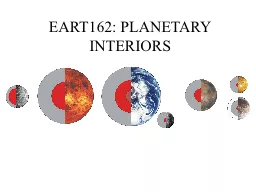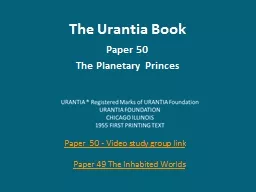PPT-EART162: PLANETARY INTERIORS
Author : stefany-barnette | Published Date : 2017-08-13
Last Week Global gravity variations arise due to MoI difference J 2 We can also determine C the moment of inertia either by observation precession or by assuming
Presentation Embed Code
Download Presentation
Download Presentation The PPT/PDF document "EART162: PLANETARY INTERIORS" is the property of its rightful owner. Permission is granted to download and print the materials on this website for personal, non-commercial use only, and to display it on your personal computer provided you do not modify the materials and that you retain all copyright notices contained in the materials. By downloading content from our website, you accept the terms of this agreement.
EART162: PLANETARY INTERIORS: Transcript
Download Rules Of Document
"EART162: PLANETARY INTERIORS"The content belongs to its owner. You may download and print it for personal use, without modification, and keep all copyright notices. By downloading, you agree to these terms.
Related Documents














